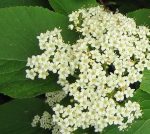 Wayfaring tree is a large deciduous shrub growing up to 15’ tall and wide and a member of the moschatel family, Adoxaceae, that also includes elders (Sambucus). It is native to open woodland and woodland edges in Europe to western Asia but has naturalized in the US and is considered invasive from Maine and Michigan, south to Maryland and Illinois. The bold dark green leaves are 2-5” long, elliptical to ovate, leathery, thick, and toothed, and have large white conspicuous veins on the underside. Flat-topped clusters of creamy white flowers 3-5” in diameter appear in spring and have a fishy odor. Fruits are green turning to red, red-orange or red-yellow by early late summer but often fail to appear. The plants are vigorous, tend to get leggy, and can become invasive. Several cultivars are available that vary in size and foliage color. The generic name, Viburnum, is the Latin name for the plant; the specific epithet, lantana, is a late Latin name for virburnums, plants with aromatic flower clusters.
Wayfaring tree is a large deciduous shrub growing up to 15’ tall and wide and a member of the moschatel family, Adoxaceae, that also includes elders (Sambucus). It is native to open woodland and woodland edges in Europe to western Asia but has naturalized in the US and is considered invasive from Maine and Michigan, south to Maryland and Illinois. The bold dark green leaves are 2-5” long, elliptical to ovate, leathery, thick, and toothed, and have large white conspicuous veins on the underside. Flat-topped clusters of creamy white flowers 3-5” in diameter appear in spring and have a fishy odor. Fruits are green turning to red, red-orange or red-yellow by early late summer but often fail to appear. The plants are vigorous, tend to get leggy, and can become invasive. Several cultivars are available that vary in size and foliage color. The generic name, Viburnum, is the Latin name for the plant; the specific epithet, lantana, is a late Latin name for virburnums, plants with aromatic flower clusters.
Type: Deciduous shrub
Outstanding Feature: Flowers, berries, bold foliage
Form: Oval and spreading
Growth Rate: Moderate
Bloom: . Flat-topped clusters of creamy white flowers with fishy odor; in spring
Size: 15’ H x 15’ W
Light: Full sun to partial shade
Soil: Average, moist, well-drained but tolerates less
Hardiness: Zones 4-7
Care: Low maintenance
Pests and Diseases: None of significance but susceptible to powdery mildew.
Propagation: Seed, softwood cuttings in early summer, layering